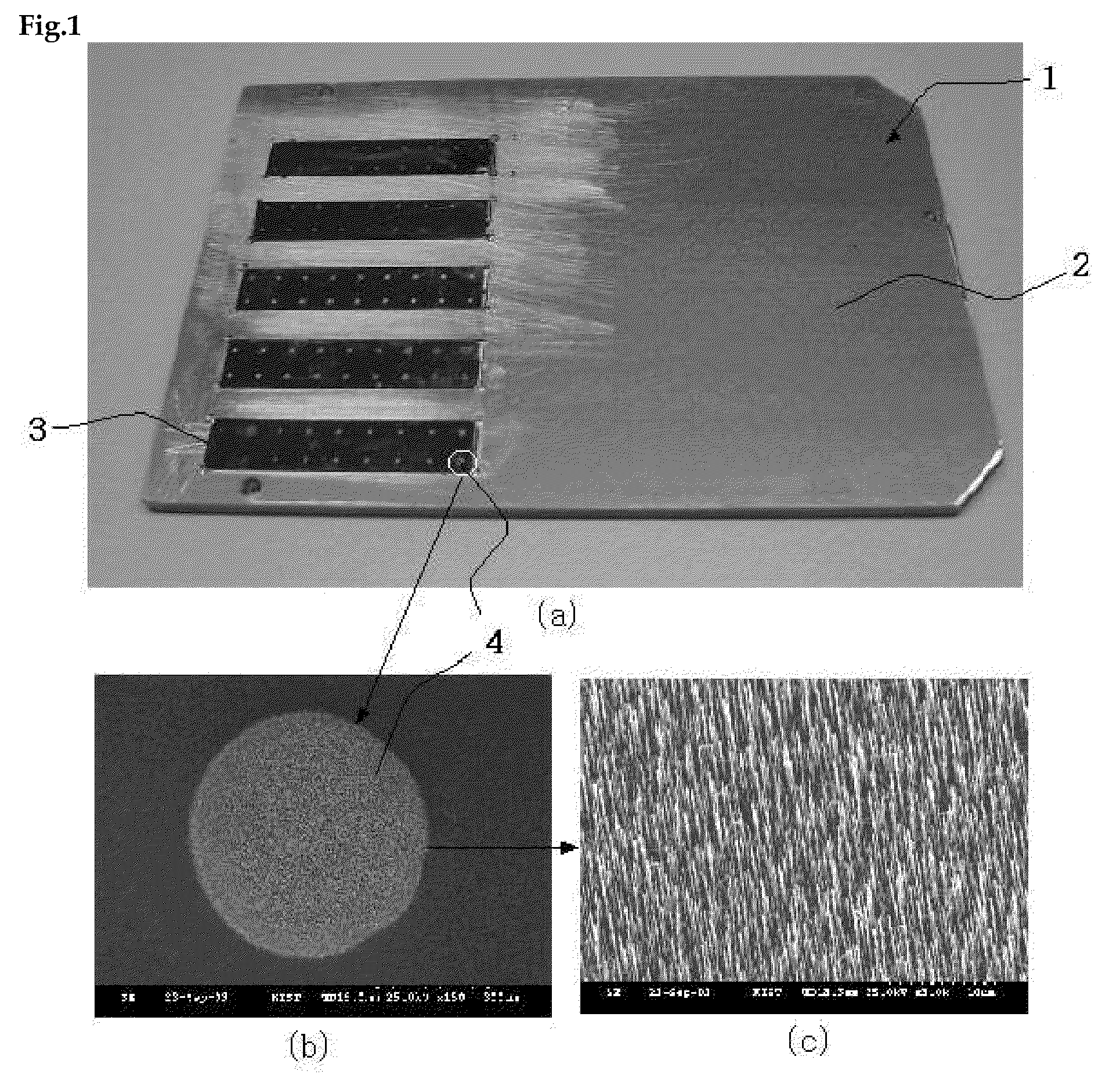Nanowire assisted laser desorption/ionization mass spectrometric analysis
a mass spectrometric analysis and laser desorption technology, applied in the direction of particle separator tube details, instruments, separation processes, etc., can solve the problems of difficult to select a suitable matrix substance for a given specimen, limited use of it, and difficult to perform an analysis for an unknown substance in a mixtur
- Summary
- Abstract
- Description
- Claims
- Application Information
AI Technical Summary
Benefits of technology
Problems solved by technology
Method used
Image
Examples
example 1
Mass Spectrometric Analysis using Nanowires
[0087]A surface of a silicon board was deposited with Au via sputtering vapor deposition method to a thickness of 2 nm, wherein the area for deposition was made circular with a diameter of 200 μm using a mask. Then, the board was supplied with SiCl4 at 500° C. via chemical vapor deposition (CVD) method, thereby allowing the growth of silicon nanowires, and FIG. 1 shows the silicon nanowires grown on the board. The silicon nanowires used were restricted to have a length of 5 μm, a diameter of 100 nm and a density of about 1.8×106 NWs / mm2. The board with thus grown nanowires was inserted into a specimen inspection plate of a mass spectrometric analysis device. The mass analysis was performed using Reflex 3 from Bruker Daltonics (Germany). The specimens used were two peptides, angiotensin and leucine enkephalin. The diameter of nanowire spot was restricted to be 0.2 mm and the crystals of specimens were irradiated by the circular spot of laser...
example 2
Mass Spectrometric Analysis using Nanowire Suspension
[0088]A surface of a silicon board was deposited with Au via sputtering vapor deposition method to a thickness of 2 nm, wherein InN nanowires were grown by supplying with InCl3 and NH3 at 500° C. via chemical vapor deposition (CVD) method. Nanowire suspension was prepared by separating nanowires from the board by placing the above silicon board in isopropyl alcohol and then applying with ultrasonic wave for 10 sec. The MALDI measurement was performed using the nanowire suspension by using MALDI target from Bruker Daltonics (Germany) instead of the typical matrix. Taking advantage of the special property of the MALDI target that crystal center of a specimen is concentrated on ankers, a small amount of nanowire suspension was treated to form nanowire islets around the ankers. Then, peptides as a specimen was dropped in the above nanowire islets and allowed to form crystals of the specimen. Upon inspection, it was found that nanowire...
example 3
Detection of Coupling Reaction using Nanowires
[0089]A nanowire target where nanowires are grown as in Example 1 was added with hepatitis B antigen solution and allowed to incubate at a 37° C. water-saturated thermostat for an hour so that the hepatitis B antigen can be fixed. Then, the nanowire target was dipped into a washing solution to separate unfixed hepatitis B antigens. A specimen solution containing the hepatitis B antigen was added to the nanowires to induce an antibody-antigen reaction and then placed the nanowire target into the washing solution to remove the specimen which was left after the antibody-antigen reaction. Then, it was confirmed that MALDI enables to perform quantitative as well as qualitative analyses of antigen-antibody coupler which was coupled to nanowires. Likewise, it is possible to quantitatively detect the couplers between DNAs, between DNA and RNA or between proteins using the nanowire MALDI target. Further, it is also possible to quantitatively dete...
PUM
| Property | Measurement | Unit |
|---|---|---|
| diameter | aaaaa | aaaaa |
| aspect ratio | aaaaa | aaaaa |
| molecular weight | aaaaa | aaaaa |
Abstract
Description
Claims
Application Information
 Login to View More
Login to View More - R&D
- Intellectual Property
- Life Sciences
- Materials
- Tech Scout
- Unparalleled Data Quality
- Higher Quality Content
- 60% Fewer Hallucinations
Browse by: Latest US Patents, China's latest patents, Technical Efficacy Thesaurus, Application Domain, Technology Topic, Popular Technical Reports.
© 2025 PatSnap. All rights reserved.Legal|Privacy policy|Modern Slavery Act Transparency Statement|Sitemap|About US| Contact US: help@patsnap.com



